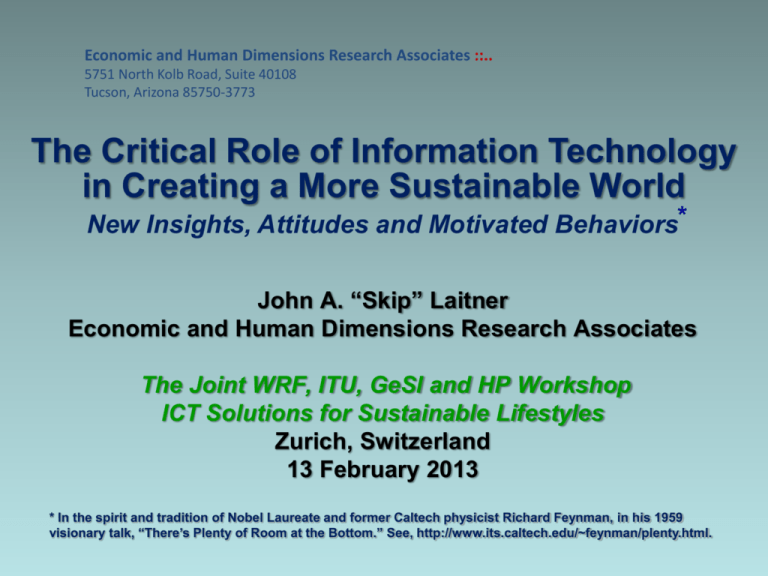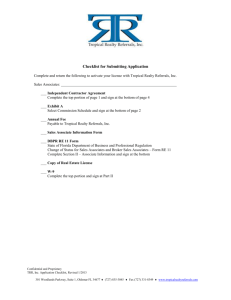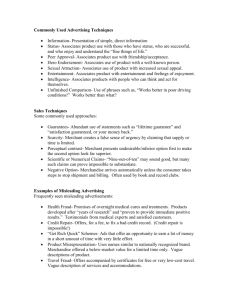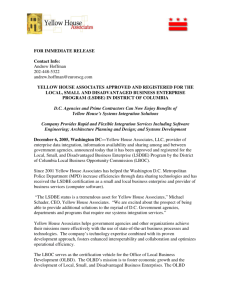Economic and Human Dimensions Research Associates
advertisement

Economic and Human Dimensions Research Associates ::.. 5751 North Kolb Road, Suite 40108 Tucson, Arizona 85750-3773 The Critical Role of Information Technology in Creating a More Sustainable World New Insights, Attitudes and Motivated Behaviors* John A. “Skip” Laitner Economic and Human Dimensions Research Associates The Joint WRF, ITU, GeSI and HP Workshop ICT Solutions for Sustainable Lifestyles Zurich, Switzerland 13 February 2013 * In the spirit and tradition of Nobel Laureate and former Caltech physicist Richard Feynman, in his 1959 visionary talk, “There’s Plenty of Room at the Bottom.” See, http://www.its.caltech.edu/~feynman/plenty.html. A Working Hypothesis The economic recovery and the full development of our long-term global prosperity will not be possible without significant increases in purposeful investment and greater levels of resource and energy efficiency – enabled by interactive information technologies and systems, and motivated by informed attitudes, and more productive behaviors. Economic and Human Dimensions Research Associates ::.. 1 Why This Issue Is Important There is a surprising connection between annual gains in energy efficiency and the larger productivity of the economy. At the same time the global economy is surprisingly energy inefficient. ‒ The energy efficiency of the U.S. economy, for example, is an anemic 14 percent, meaning that 86 percent of all energy resources are wasted in the production of goods and services. ‒ Other developed economies as Japan, the European Union, and Switzerland are only marginally better. ‒ That level of waste imposes huge constraints on the larger wellbeing of our global economy. Perhaps the most immediate opportunity to ensure a more robust and sustainable economy is to quadruple or better our levels of energy (in)efficiency. Information and communication technologies (ICT) and broadband services – the use of what we call “intelligent efficiency”– may provide the critical path forward to ensure a greater and a longer-term global economic productivity. Economic and Human Dimensions Research Associates ::.. 2 At the Same Time. . . Yes, energy efficiency in the U.S. has already met 75% of new demands for energy-related goods and services since 1970 while new energy supplies have met only 25% of those new demands. But energy efficiency gains are a highly invisible and a seriously lagging success story. And, we are in the midst of a weakened economic productivity that may be severely impacted by energy constraints, as well as by growing demands from developing economies. As we look at the emergence of new communication and new energy systems, we are on the cusp of what my colleague Jeremy Rifkin, in his new book, refers to as the Third Industrial Revolution: • First era: roughly corresponding to use of print media and coal/steam energy • Second era: use of telecommunications and petroleum • Emerging third era: interactive communications and distributed clean energy Economic and Human Dimensions Research Associates ::.. 3 Intelligent Efficiency People-Centered Initiatives (RealTime Feedback and Engagement): Digital Energy Management (Automation and Optimization): Providing real-time information and management tools that enable consumers building owners and operators, manufacturers, and other users to adjust energy consumption in response to changing information. Examples: Building energy use displays and comparisons Real-time pricing and smart meters Immediate market information to facilitate optimal buying and selling Using sensors, controls, and computer software to automate business processes or building operations in order to optimize energy use. This bypasses much of the need for people to respond. Examples: Building sensor and control systems Optimization between different sets of systems, like AC, lighting, computer use Smart Manufacturing Substitution with Energy-Saving ICT Services: Smart, Highly Interconnected Land Use and Infrastructure: Shifting behaviors, services and structure of the economy in ways that displace more energyintensive activities. Examples: Video conferencing instead of traveling for inperson meeting; teleworking Kindle, Nook, instead of printing books Online shopping instead of consumers driving to stores Integrating optimized and more productive infrastructure with smart growth and resilient development. Examples: Systems approach to community and transportation planning Traffic signal optimization Zip cars Robust electricity and communication microgrids Economic and Human Dimensions Research Associates ::.. 4 Purposeful Effort is Required to Respond to the Economic and Climate Imperatives Performance, Productivity and Returns Standard Technology Some might say this is about where we are on the curve at the moment Time Economic and Human Dimensions Research Associates ::.. 5 Purposeful Effort is Required to Respond to the Economic and Climate Imperatives Performance, Productivity and Returns Smart Infrastructure and ICT-Enabled Technology Systems Standard Technology Transformation Cumulative Investment and Purposeful Effort Economic and Human Dimensions Research Associates ::.. 6 Jumping to the End of the Story The new ACEEE report, “The Long-Term Energy Efficiency Potential: What the Evidence Suggests,” shows how slashing U.S. energy consumption by 40 to 60% ‒ all done through highly cost-effective efficiency investments ‒ could generate up to 2 million jobs while saving all residential and business consumers a net $400 billion per year, or the equivalent of about $2,600 per household annually. The key insight? Instead of tiny increments, the US will be better off ‘Thinking Big’ about energy productivity and energy services, rather than relying on the usual set of very costly and conventional energy resources. Source: The Long-Term Energy Efficiency Potential: What the Evidence Suggests (2012). Washington, DC: ACEEE. http://www.aceee.org/press/2012/01/aceee-report-us-better-thinking-big- Economic and Human Dimensions Research Associates ::.. Sources: The Long-Term Energy Efficiency Potential: What the Evidence Suggests (2012). Washington, DC: ACEEE. http://www.aceee.org/press/2012/01/aceee-report-us-better-thinking-bigJohn A. “Skip” Laitner. 2013. “The Link Between Energy Efficiency, Useful Work, and a Robust Economy,” in John Byrne and Yang-doo Wang (editors), Secure and Green Energy Economies (forthcoming). Economic and Human Dimensions Research Associates ::.. Just One of Many Examples: Optimizing the U.S. Traffic Signals There are an estimated 272,000 traffic signal systems throughout the United States today. Stop and start driving and poorly timed signals cause unnecessary fuel consumption on our nation’s highways. Retrofitting these systems with smart sensors and dynamic programming techniques can improve traffic flow that, in turn, can reduce highway fuel consumption by 5-10% per year. The cost? About $10-12 per household. The savings? About $150 per household per year – and possibly more! ICT and smart infrastructure can be a critical enabler. Economic and Human Dimensions Research Associates ::.. 9 Yet, we must also explore the behavioral elements as a means to reinvigorate the economic imperative of energy efficiency. . . Economic and Human Dimensions Research Associates ::.. 10 A Critical Observation • • Yes. . . “Science and technology can create much better choices.” (Former DOE Secretary Chu 2009) But we won’t get there unless we bring people back into the process. Or More Prosaically. . . A revolution doesn’t happen when society adopts new tools, it happens when society adopts new behaviors. Clay Shirky NYU Telecommunications Professor Economic and Human Dimensions Research Associates ::.. How Important is Behavior? People as Problem? Or. . . People as Solution? Buildings would work perfectly if it weren’t for the people in them. -- Anonymous, ACEEE Conference, circa 1993 Economic and Human Dimensions Research Associates ::.. The Foundation of an Energy Revolution • Engaging and empowering the entire population to adopt new behaviors, and to create a dynamically new energy culture. • We need to get people to do things differently. • How do we do that? Economic and Human Dimensions Research Associates ::.. 13 Managing an Invisible Resource • • • • Unlike previous eras – today’s energy resources are invisible. People no longer cut wood or shovel coal. Electricity enters our homes in seamless and silent ways. Our only means of assessing our level of consumption is the bill that we pay each month. So the very first step is feedback – a mechanism for making energy visible, a tool for learning, and a means of generating confidence and effective response. Economic and Human Dimensions Research Associates ::.. 14 How do we Engage People? INFORMATION…providing information about energy consumption, technologies, programs, priorities, and amount of savings achieved. Energy Consumption Feedback Savings: 20% Residential Feedback Savings: 4-12% Cisco Mediator Economic and Human Dimensions Research Associates ::.. Residential Feedback Approaches Average Household Electricity Savings (4-12%) For Historical Programs by Feedback Type Ehrhardt-Martinez, K., Donnelly, K.A., and Laitner, J.A. 2010 A meta-review of 57 different feedback programs 12.0% Annual Percent Savings 9.2% 8.4% 6.8% 3.8% Enhanced Billing Householdspecific info, advice Estimated Feedback Web-based energy audits with info on ongoing basis Daily/ Weekly Feedback Householdspecific info, advise on daily or weekly basis Real-Time Feedback Real-time premise level info Real-Time Plus Feedback Real-time info down to the appliance level “Indirect” Feedback “Direct” Feedback (Provided Real Time) (Provided after Consumption Occurs) Economic and Human Dimensions Research Associates ::.. Potential Resource Savings: 20 to 35% Real-Time Plus Feedback w/ Smart Program Design Plus Application of Smart Social Science Insights Three Targets/Mechanisms of Change Use insights from the Social Sciences to understand: 1. The effectiveness of energy feedback systems 2. The impact of the scale and design of both smart grid and smart infrastructure on community-level engagement, and 3. The relationship between feedback, measures of confidence and effectiveness, and other determinants of deep building retrofits and other large-scale efficiency improvements. All enabled by Information and Communication Technologies Economic and Human Dimensions Research Associates ::.. Perhaps Our Ultimate Economic and Energy Efficiency Resource? • • • Recalling the comment of early Twentieth Century UK essayist, Lionel Strachey, who remarked: “Americans guess because they are in too great a hurry to think.” Jerry Hirschberg, founder and former CEO of Nissan Design, who noted that: “Creativity is not an escape from disciplined thinking. It is an escape with disciplined thinking." And Henry Ford once said, “Thinking is the hardest work there is which is the probable reason why so few engage in it.” Economic and Human Dimensions Research Associates ::.. The Key Take-Aways • The energy efficiency resource is larger and more necessary to develop than is generally understood • Engaging, empowering and motivating consumers is a critical first step in building large-scale savings. • For real, deep, and lasting change, a layered approach to changing behavior is important – using multiple methods and means of reaching people, as individuals, but also as family members, neighbors, and co-workers! • And not discussed today, but also the need for new business models that shift from the sale of commodities to providing value-added services, and do so in ways that save businesses and consumers money while generating positive returns for investors. Economic and Human Dimensions Research Associates ::.. The difficulty lies not with the new ideas, but in escaping the old ones. . . . John Maynard Keynes Economic and Human Dimensions Research Associates ::.. For further information and citations to the resources and references cited: John A. “Skip” Laitner c: (571) 332-9434 email: econskip@gmail.com See our eBook on the behavior resource: Karen Ehrhardt-Martinez and John A. “Skip” Laitner, Editors People-Centered Initiatives for Increasing Energy Savings Washington, DC: American Council for an Energy-Efficient Economy www.aceee.org/node/9275 See also my Desert Year Blog: Running with the Lizards and Doing a 180 on Energy http://www.realclimateeconomics.org/wp/archives/1261 Economic and Human Dimensions Research Associates ::..





